Abstract
This investigation was undertaken in order to (a) characterize the postprandial inflow of individual bile acids to the liver and (b) determine if peripheral venous bile acid levels always adequately reflect the portal venous concentration, or if saturation of hepatic bile acid uptake can occur under physiological conditions. In five patients with uncomplicated cholesterol gallstone disease, the umbilical cord was cannulated during cholecystectomy, and a catheter was left in the left portal branch for 5 to 7 d. The serum concentrations of cholic acid, chenodeoxycholic acid, and deoxycholic acid in portal venous and systemic circulation were then determined at intervals of 15 to 30 min before and after a standardized meal. A highly accurate and specific gas chromatographic/mass spectrometric technique was used.
The sum of the fasting concentrations of the three bile acids averaged 14.04±4.13 μmol/liter in portal venous serum, and 2.44±0.31 μmol/liter in peripheral venous serum. The estimated hepatic fractional uptake of cholic acid was ∼90%, and those of chenodeoxycholic acid and deoxycholic acid were 70-80%. This resulted in an enrichment of systemic bile acids in the dihydroxy bile acid species. In response to a standardized meal, portal venous bile acid concentrations increased two- to sixfold, with a peak seen 15-60 min after the meal. The maximum postprandial portal venous bile acid concentration averaged 43.04±6.12 μmol/liter, and the corresponding concentration in peripheral serum was 5.22±0.74 μmol/liter. The estimated fractional uptakes of the individual bile acids were not affected by the increased inflow to the liver. The peripheral venous concentrations of individual as well as total bile acids were well correlated with those in portal venous serum.
The results (a) give a quantitation of postprandial bile acid inflow to the liver and (b) indicate that the hepatic uptake system for bile acids in healthy man cannot be saturated during maximal inflow of endogenous bile acids. Measurement of peripheral serum bile acids can thus give important information on the status of the enterohepatic circulation.
Full text
PDF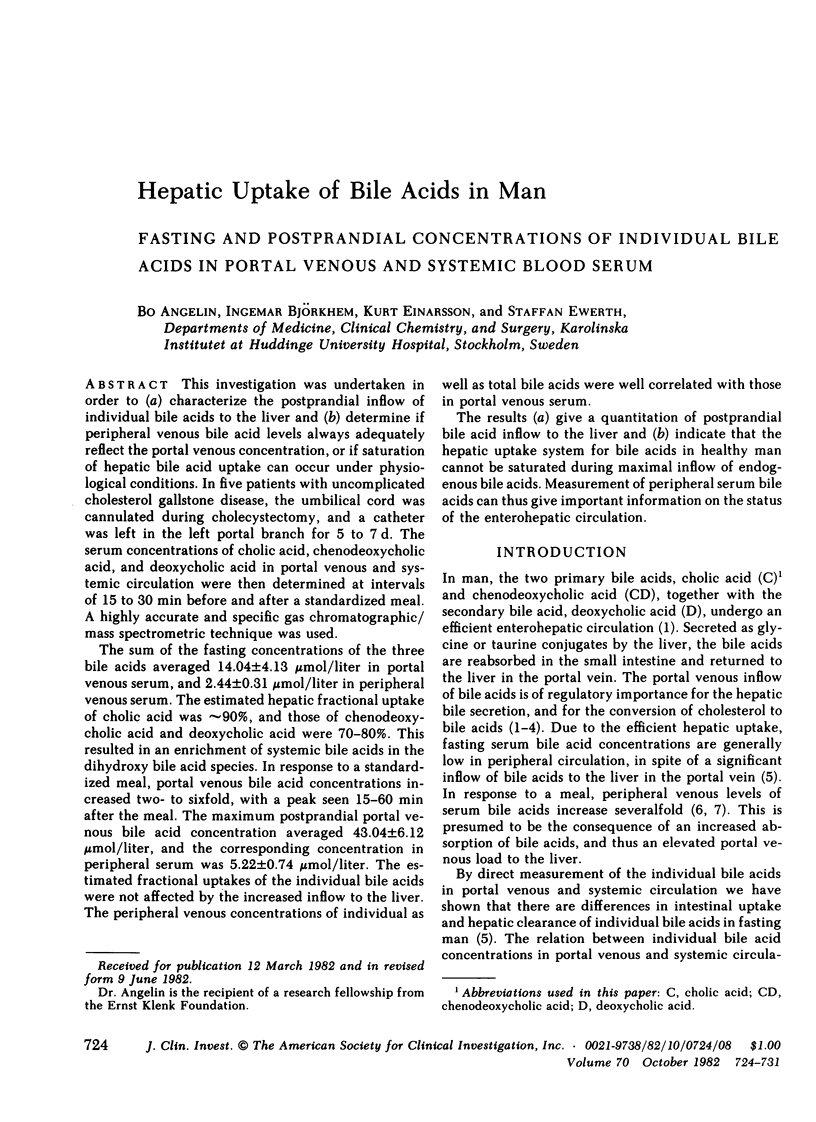
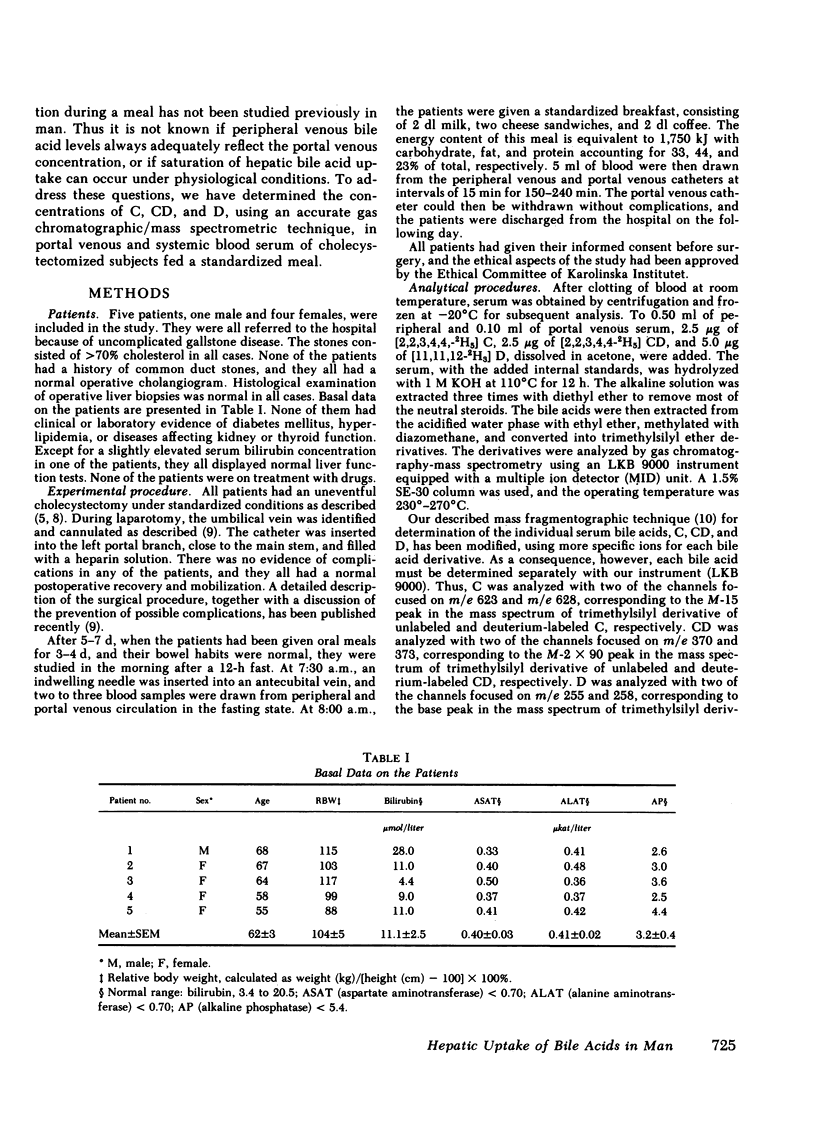
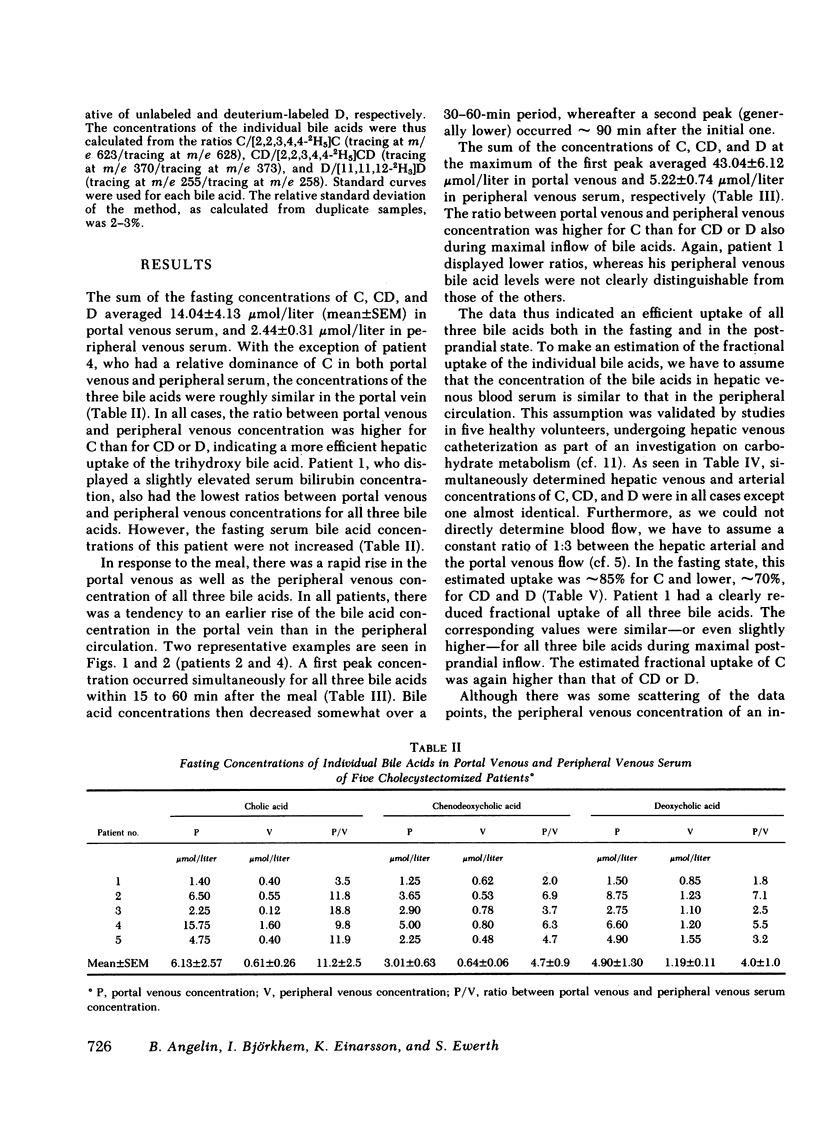
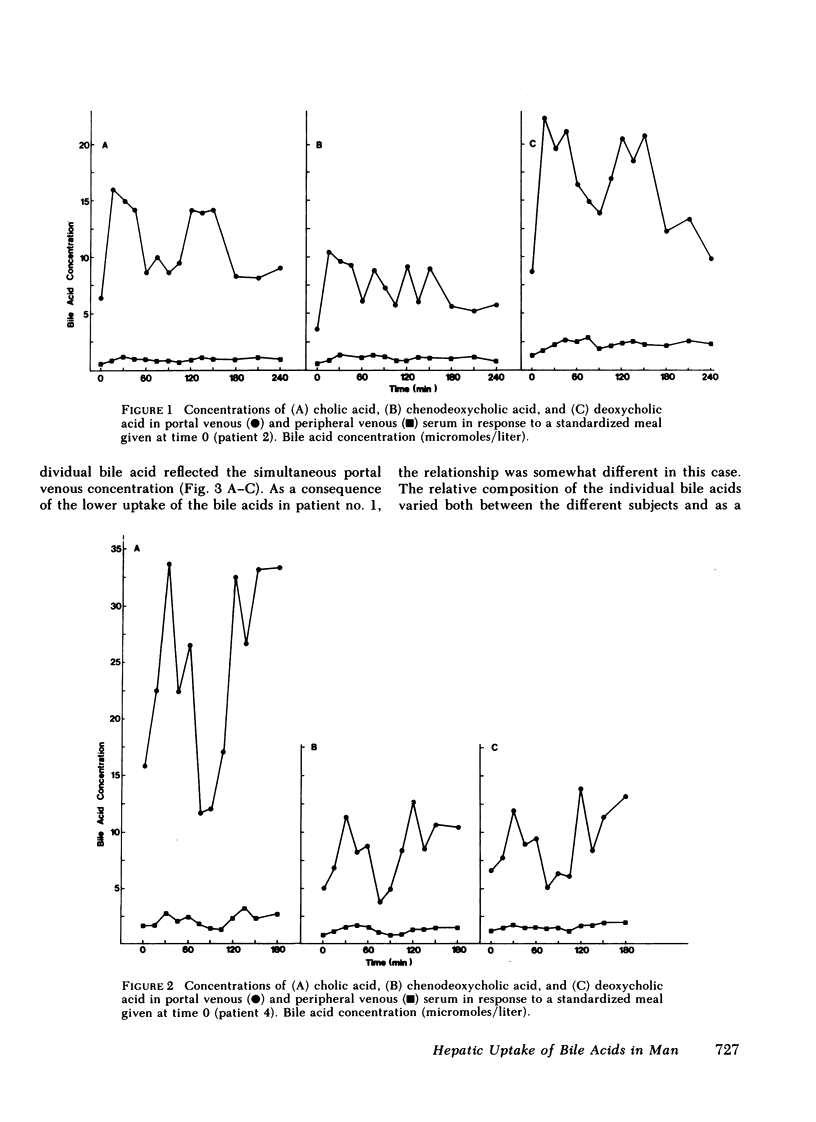
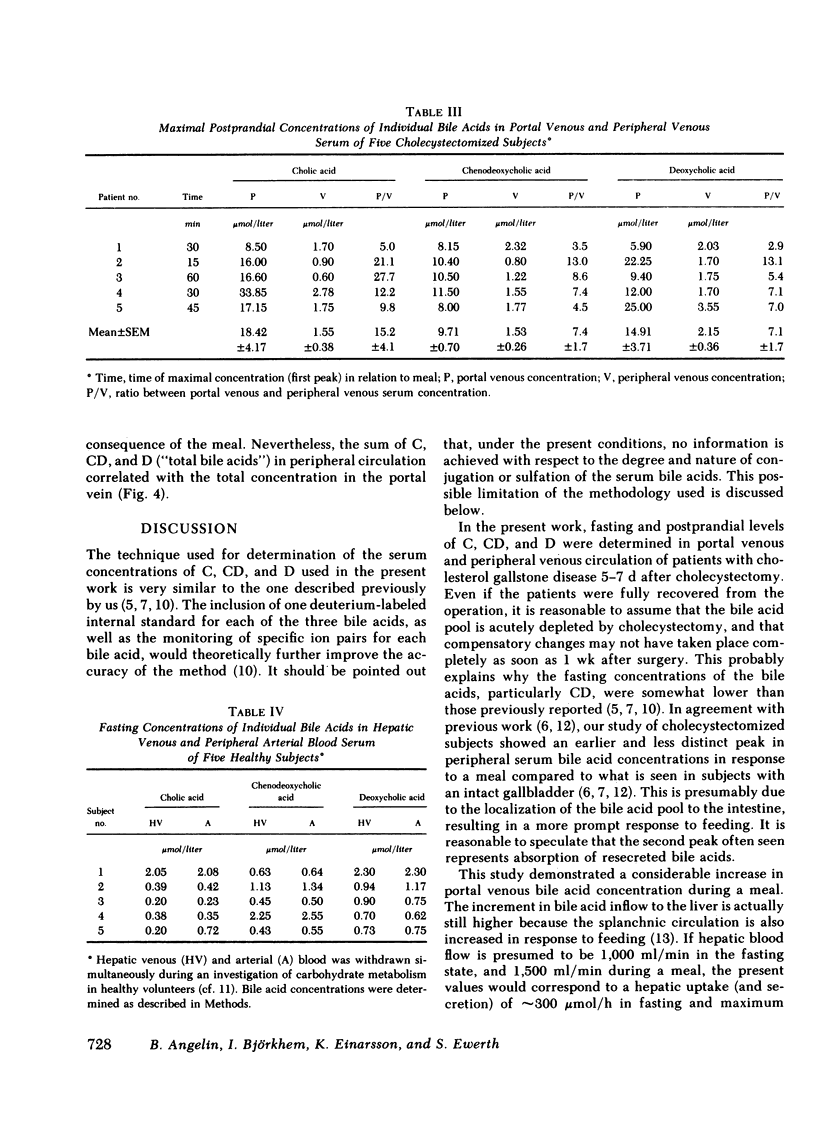
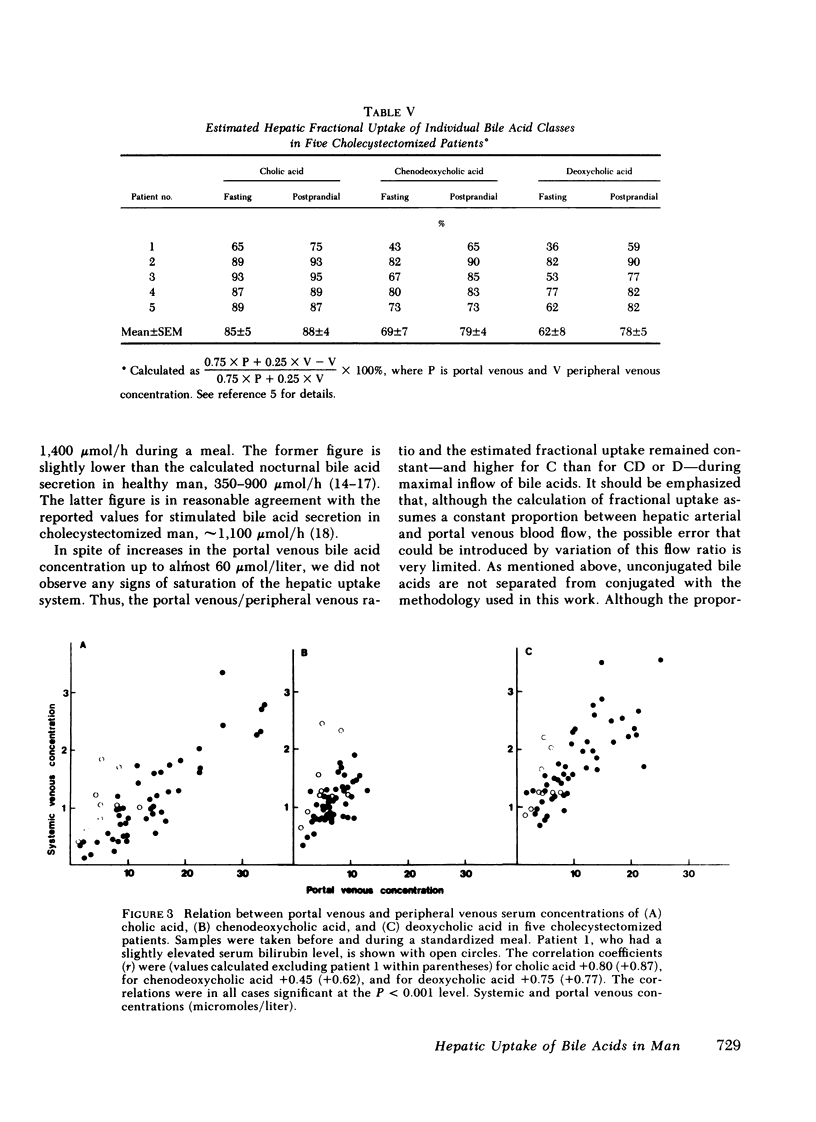
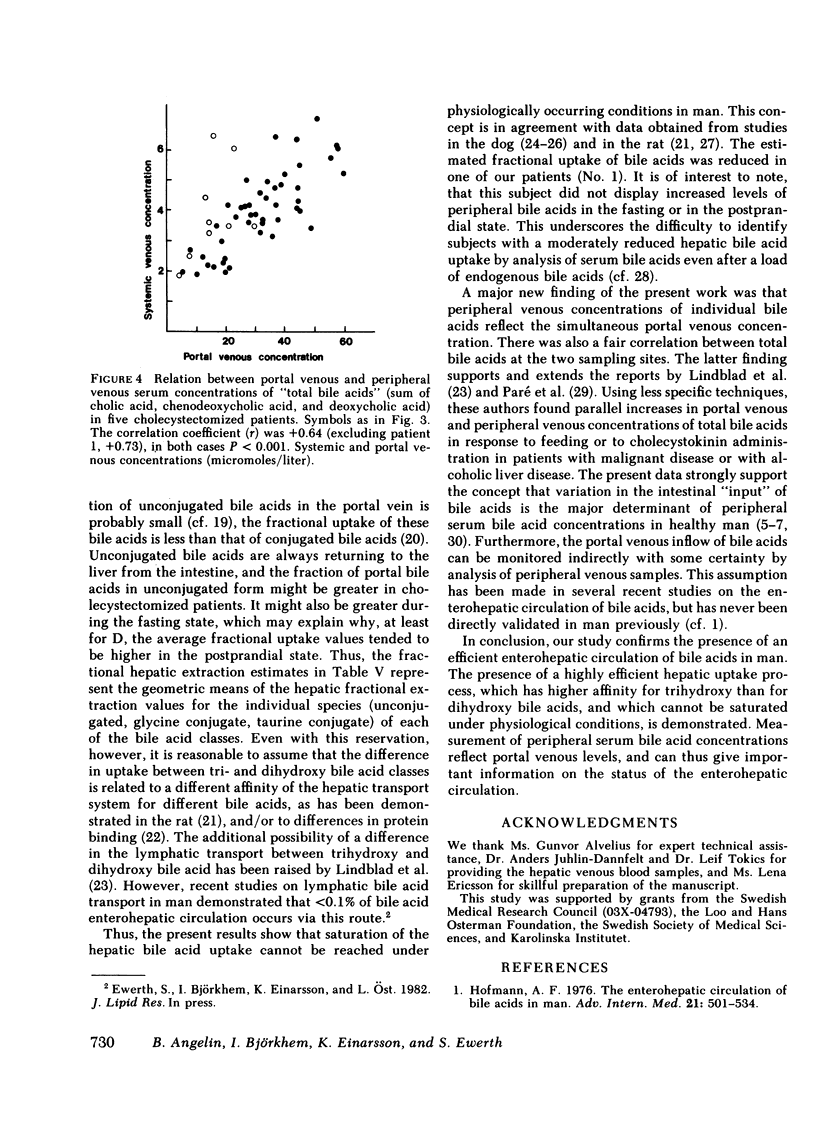
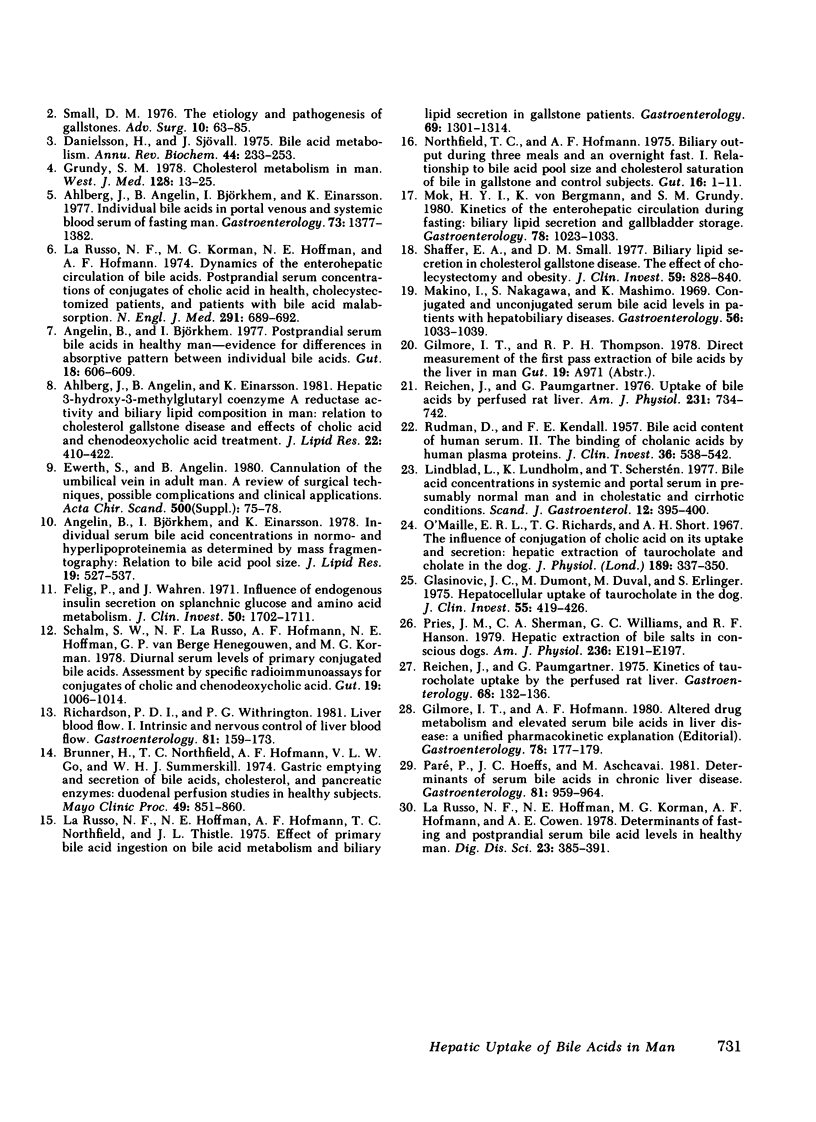
Selected References
These references are in PubMed. This may not be the complete list of references from this article.
- Ahlberg J., Angelin B., Björkhem I., Einarsson K. Individual bile acids in portal venous and systemic blood serum of fasting man. Gastroenterology. 1977 Dec;73(6):1377–1382. [PubMed] [Google Scholar]
- Ahlberg J., Angelin B., Einarsson K. Hepatic 3-hydroxy-3-methylglutaryl coenzyme A reductase activity and biliary lipid composition in man: relation to cholesterol gallstone disease and effects of cholic acid and chenodeoxycholic acid treatment. J Lipid Res. 1981 Mar;22(3):410–422. [PubMed] [Google Scholar]
- Angelin B., Bjökhem I., Einarsson K. Individual serum bile acid concentrations in normo- and hyperlipoproteinemia as determined by mass fragmentography: relation to bile acid pool size. J Lipid Res. 1978 Jul;19(5):527–537. [PubMed] [Google Scholar]
- Angelin B., Björkhem I. Postprandial serum bile acids in healthy man. Evidence for differences in absorptive pattern between individual bile acids. Gut. 1977 Aug;18(8):606–609. doi: 10.1136/gut.18.8.606. [DOI] [PMC free article] [PubMed] [Google Scholar]
- Brunner H., Northfield T. C., Hofmann A. F., Go V. L., Summerskill W. H. Gastric emptying and secretion of bile acids, cholesterol, and pancreatic enzymes during digestion. Duodenal perfusion studies in healthy subjects. Mayo Clin Proc. 1974 Nov;49(11):851–860. [PubMed] [Google Scholar]
- Danielsson H., Sjövall J. Bile acid metabolism. Annu Rev Biochem. 1975;44:233–253. doi: 10.1146/annurev.bi.44.070175.001313. [DOI] [PubMed] [Google Scholar]
- Erlinger S. Hepatocellular uptake of taurocholate in the dog. J Clin Invest. 1975 Feb;55(2):419–426. doi: 10.1172/JCI107946. [DOI] [PMC free article] [PubMed] [Google Scholar]
- Ewerth S., Angelin B. Cannulation of the umbilical vein in adult man. A review of surgical techniques, possible complications and clinical applications. Acta Chir Scand Suppl. 1980;500:75–78. [PubMed] [Google Scholar]
- Felig P., Wahren J. Influence of endogenous insulin secretion on splanchnic glucose and amino acid metabolism in man. J Clin Invest. 1971 Aug;50(8):1702–1711. doi: 10.1172/JCI106659. [DOI] [PMC free article] [PubMed] [Google Scholar]
- Gilmore I. T., Hofmann A. F. Altered drug metabolism and elevated serum bile acids in liver disease: a unified pharmacokinetic explanation. Gastroenterology. 1980 Jan;78(1):177–179. [PubMed] [Google Scholar]
- Grundy S. M. Cholesterol metabolism in man. West J Med. 1978 Jan;128(1):13–25. [PMC free article] [PubMed] [Google Scholar]
- Hofmann A. F. The enterohepatic circulation of bile acids in man. Adv Intern Med. 1976;21:501–534. [PubMed] [Google Scholar]
- LaRusso N. F., Hoffman N. E., Hofmann A. F., Northfield T. C., Thistle J. L. Effect of primary bile acid ingestion on bile acid metabolism and biliary lipid secretion in gallstone patients. Gastroenterology. 1975 Dec;69(6):1301–1314. [PubMed] [Google Scholar]
- LaRusso N. F., Hoffman N. E., Korman M. G., Hofmann A. F., Cowen A. E. Determinants of fasting and postprandial serum bile acid levels in healthy man. Am J Dig Dis. 1978 May;23(5):385–391. doi: 10.1007/BF01072919. [DOI] [PubMed] [Google Scholar]
- LaRusso N. F., Korman M. G., Hoffman N. E., Hofmann A. F. Dynamics of the enterohepatic circulation of bile acids. Postprandial serum concentrations of conjugates of cholic acid in health, cholecystectomized patients, and patients with bile acid malabsorption. N Engl J Med. 1974 Oct 3;291(14):689–692. doi: 10.1056/NEJM197410032911401. [DOI] [PubMed] [Google Scholar]
- Lindblad L., Lundholm K., Schersten T. Bile acid concentrations in systemic and portal serum in presumably normal man and in cholestatic and cirrhotic conditions. Scand J Gastroenterol. 1977;12(4):395–400. doi: 10.3109/00365527709181679. [DOI] [PubMed] [Google Scholar]
- Makino I., Nakagawa S., Mashimo K. Conjugated and unconjugated serum bile acid levels n patients with hepatobiliary diseases. Gastroenterology. 1969 Jun;56(6):1033–1039. [PubMed] [Google Scholar]
- Mok H. Y., Von Bergmann K., Grundy S. M. Kinetics of the enterohepatic circulation during fasting: biliary lipid secretion and gallbladder storage. Gastroenterology. 1980 May;78(5 Pt 1):1023–1033. [PubMed] [Google Scholar]
- Northfield T. C., Hofmann A. F. Biliary lipid output during three meals and an overnight fast. I. Relationship to bile acid pool size and cholesterol saturation of bile in gallstone and control subjects. Gut. 1975 Jan;16(1):1–11. doi: 10.1136/gut.16.1.1. [DOI] [PMC free article] [PubMed] [Google Scholar]
- O'Máille E. R., Richards T. G., Short A. H. The influence of conjugation of cholic acid on its uptake and secretion: hepatic extraction of taurocholate and cholate in the dog. J Physiol. 1967 Apr;189(2):337–350. doi: 10.1113/jphysiol.1967.sp008172. [DOI] [PMC free article] [PubMed] [Google Scholar]
- Paré P., Hoefs J. C., Ashcavai M. Determinants of serum bile acids in chronic liver disease. Gastroenterology. 1981 Nov;81(5):959–964. [PubMed] [Google Scholar]
- Pries J. M., Sherman C. A., Williams G. C., Hanson R. F. Hepatic extraction of bile salts in conscious dogs. Am J Physiol. 1979 Feb;236(2):E191–E197. doi: 10.1152/ajpendo.1979.236.2.E191. [DOI] [PubMed] [Google Scholar]
- RUDMAN D., KENDALL F. E. Bile acid content of human serum. II. The binding of cholanic acids by human plasma proteins. J Clin Invest. 1957 Apr;36(4):538–542. doi: 10.1172/JCI103451. [DOI] [PMC free article] [PubMed] [Google Scholar]
- Reichen J., Paumgartner G. Kinetics of taurocholate uptake by the perfused rat liver. Gastroenterology. 1975 Jan;68(1):132–136. [PubMed] [Google Scholar]
- Reichen J., Paumgartner G. Uptake of bile acids by perfused rat liver. Am J Physiol. 1976 Sep;231(3):734–742. doi: 10.1152/ajplegacy.1976.231.3.734. [DOI] [PubMed] [Google Scholar]
- Richardson P. D., Withrington P. G. Liver blood flow. I. Intrinsic and nervous control of liver blood flow. Gastroenterology. 1981 Jul;81(1):159–173. [PubMed] [Google Scholar]
- Schalm S. W., LaRusso N. F., Hofmann A. F., Hoffman N. E., van Berge-Henegouwen G. P., Korman M. G. Diurnal serum levels of primary conjugated bile acids. Assessment by specific radioimmunoassays for conjugates of cholic and chenodeoxycholic acid. Gut. 1978 Nov;19(11):1006–1014. doi: 10.1136/gut.19.11.1006. [DOI] [PMC free article] [PubMed] [Google Scholar]
- Shaffer E. A., Small D. M. Biliary lipid secretion in cholesterol gallstone disease. The effect of cholecystectomy and obesity. J Clin Invest. 1977 May;59(5):828–840. doi: 10.1172/JCI108705. [DOI] [PMC free article] [PubMed] [Google Scholar]
- Small D. M. Part I. The etiology and pathogenesis of gallstones. Adv Surg. 1976;10:63–85. [PubMed] [Google Scholar]


